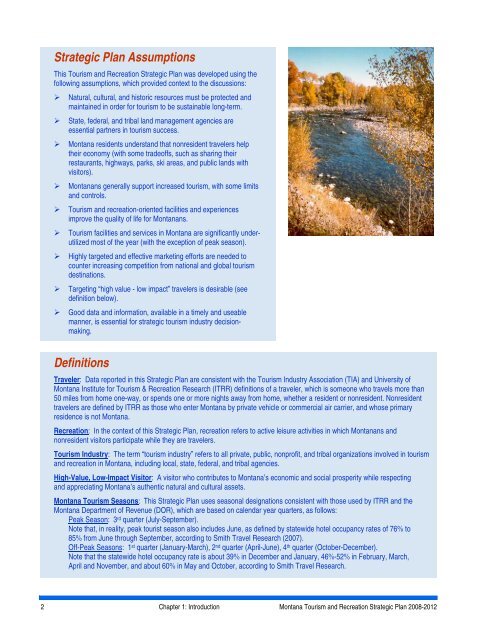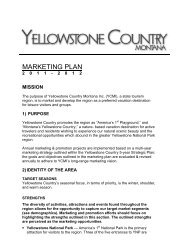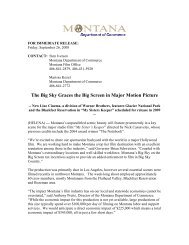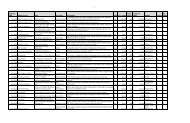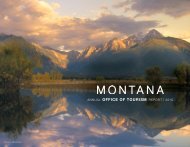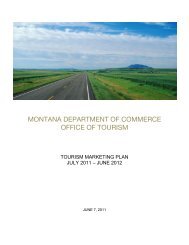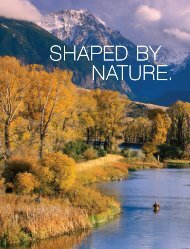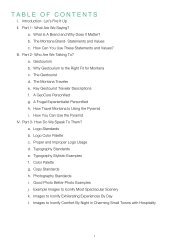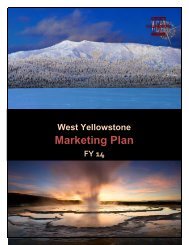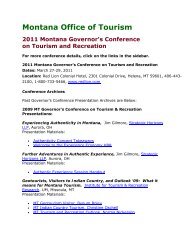Strategic Plan AssumptionsThis <strong>Tourism</strong> and Recreation Strategic Plan was developed using thefollowing assumptions, which provided context to the discussions:‣ Natural, cultural, and historic resources must be protected andmaintained in order for tourism to be sustainable long-term.‣ State, federal, and tribal land management agencies areessential partners in tourism success.‣ <strong>Montana</strong> residents understand that nonresident travelers helptheir economy (with some trade<strong>of</strong>fs, such as sharing theirrestaurants, highways, parks, ski areas, and public lands withvisitors).‣ <strong>Montana</strong>ns generally support increased tourism, with some limitsand controls.‣ <strong>Tourism</strong> and recreation-oriented facilities and experiencesimprove the quality <strong>of</strong> life for <strong>Montana</strong>ns.‣ <strong>Tourism</strong> facilities and services in <strong>Montana</strong> are significantly underutilizedmost <strong>of</strong> the year (with the exception <strong>of</strong> peak season).‣ Highly targeted and effective marketing efforts are needed tocounter increasing competition from national and global tourismdestinations.‣ Targeting “high value - low impact” travelers is desirable (seedefinition below).‣ Good data and information, available in a timely and useablemanner, is essential for strategic tourism industry decisionmaking.DefinitionsTraveler: Data reported in this Strategic Plan are consistent with the <strong>Tourism</strong> Industry Association (TIA) and University <strong>of</strong><strong>Montana</strong> Institute for <strong>Tourism</strong> & Recreation Research (ITRR) definitions <strong>of</strong> a traveler, which is someone who travels more than50 miles from home one-way, or spends one or more nights away from home, whether a resident or nonresident. Nonresidenttravelers are defined by ITRR as those who enter <strong>Montana</strong> by private vehicle or commercial air carrier, and whose primaryresidence is not <strong>Montana</strong>.Recreation: In the context <strong>of</strong> this Strategic Plan, recreation refers to active leisure activities in which <strong>Montana</strong>ns andnonresident visitors participate while they are travelers.<strong>Tourism</strong> Industry: The term “tourism industry” refers to all private, public, nonpr<strong>of</strong>it, and tribal organizations involved in tourismand recreation in <strong>Montana</strong>, including local, state, federal, and tribal agencies.High-Value, Low-Impact Visitor: A visitor who contributes to <strong>Montana</strong>’s economic and social prosperity while respectingand appreciating <strong>Montana</strong>’s authentic natural and cultural assets.<strong>Montana</strong> <strong>Tourism</strong> Seasons: This Strategic Plan uses seasonal designations consistent with those used by ITRR and the<strong>Montana</strong> Department <strong>of</strong> Revenue (DOR), which are based on calendar year quarters, as follows:Peak Season: 3 rd quarter (July-September).Note that, in reality, peak tourist season also includes June, as defined by statewide hotel occupancy rates <strong>of</strong> 76% to85% from June through September, according to Smith Travel Research (2007).Off-Peak Seasons: 1 st quarter (January-March), 2 nd quarter (April-June), 4 th quarter (October-December).Note that the statewide hotel occupancy rate is about 39% in December and January, 46%-52% in February, March,April and November, and about 60% in May and October, according to Smith Travel Research.2 <strong>Chapter</strong> 1: <strong>Introduction</strong> <strong>Montana</strong> <strong>Tourism</strong> and Recreation Strategic Plan 2008-2012
Strategic Plan Purpose and ProcessStrategic Plan Specifies Actions for Sustainable <strong>Tourism</strong>This <strong>Tourism</strong> and Recreation Strategic Plan provides the road map to strategic andsustainable tourism development in <strong>Montana</strong> from 2008 to 2012, and goes wellbeyond tourism promotion by addressing resource management, workforcedevelopment, affordable housing, transportation, and tourism-related communityenhancement issues. The Strategic Plan:♦ Serves as a blueprint for a strategic, integrated approach to tourism andrecreation development and marketing in <strong>Montana</strong>.♦ Confirms priorities to focus resources.♦ Balances <strong>Montana</strong>’s tourism promotion efforts, products, and partnerships.♦ Assigns responsibilities for implementation.♦ Identifies funding sources to pay for actions.♦ Measures results and return on investment.Nonresident Travelers Bring $3 Billion Annually to <strong>Montana</strong>Nonresident traveler spending contributes nearly $3 billion to <strong>Montana</strong>’s economy, <strong>of</strong>which $300+ million is lodging sales that generates more than $12 million in lodgingfacility use taxes (4%) and more than $9 million in select sales accommodations taxes(3%). Total nonresident tourism expenditures doubled from 1995 to 2005 ($1.36 billionto $2.76 billion), and the industry continues to grow at a healthy pace. These revenuessupport facilities and services that improve the quality <strong>of</strong> life in <strong>Montana</strong>.<strong>Tourism</strong> Supports <strong>Montana</strong>’s Other Economic Development EffortsIn most communities, 75% <strong>of</strong> the businesses depend on wealth attracted from outsidethe community by the 25% <strong>of</strong> businesses with national and global markets – includingtourism businesses. <strong>Tourism</strong> is an essential component <strong>of</strong> <strong>Montana</strong>’s economy:tourism attracts new revenues and business investment by promoting a positive image<strong>of</strong> the state, showcasing its quality <strong>of</strong> life and people, and generating increased visitorspending. <strong>Tourism</strong> benefits <strong>Montana</strong> communities, and it also provides a means forsocial exchanges between <strong>Montana</strong>ns and visitors from around the world.<strong>Tourism</strong> Seasonality Results in 4.6 Million Vacant Room NightsNearly half <strong>of</strong> all lodging sales in <strong>Montana</strong> occur in the third quarter (July-September),and two-thirds occur in the second and third quarters combined (see figure at right).Therefore, most <strong>Montana</strong> hotels and other tourism facilities are underutilized much <strong>of</strong>the year. There were more than 4.6 million vacant hotel room nights in 2006,particularly in November through April, based on a statewide year-round hoteloccupancy rate <strong>of</strong> 59.5% (the national average was 64%). 1 If filled, those vacant hotelrooms would have generated $309 million in revenue, and $21.7 million in lodgingtaxes, based on the 2006 average room rate in <strong>Montana</strong> <strong>of</strong> $67.73 per night (thenational average was $95.64). The underutilization creates instability in tourismindustry revenues and jobs, and affects other sectors <strong>of</strong> <strong>Montana</strong>’s economy.In 2006, there were more than 4.6 million vacant hotel room nights in <strong>Montana</strong>. If filled,those rooms would have generated $309 million in revenue, and $21.7 million in lodgingtaxes. Growth in <strong>of</strong>f-peak season tourism would help address underutilization.1 Smith Travel Report, 20062006 <strong>Montana</strong> <strong>Tourism</strong>Fast FactsNonresident visitors: 10.4 millionExpenditures: $2.9 billionSeasonality: 70% visit Apr-Sept30% visit Oct-MarReason for Trip: 34% Vacation27% Passing Through19% Visiting Friends & Family13% Business, 8% ShoppingOrigin: 12% WA, 10% ID, 8% WY,7% CA, 5% ND/UT, 4% CO/MN,8% Canada, 2% OverseasTravel Party Composition:32% couples28% family/extended family27% traveling aloneActivities While in <strong>Montana</strong>:45% Driving for Pleasure32% Wildlife Watching26% Recreational Shopping:23% Day Hiking20% Picnicking19% Visiting Historic Sites14% ea. L&C Sites, Museums:11% Fishing/Nature Study10% Native American Sites10% Camping (developed)8% Festivals or Events6% Gambling5% ea. Dnhll Skiing, Birding,Rafting, Horse Riding4% ea. Golf, Art Exhibits3% ea. Biking, ATVing,Backpacking, Paddling,Hunting, Sports EventSource: ITRR2006 Lodging Facility Use TaxCollections by QuarterSource: MT Dept. <strong>of</strong> Rev enueQ2$3,756,35123%Q1$2,790,58317%Q3$6,848,67543%Q4$2,700,56717%<strong>Montana</strong> <strong>Tourism</strong> and Recreation Strategic Plan 2008-2012 <strong>Chapter</strong> 1: <strong>Introduction</strong> 3


